Lesson 17 School Science Fair 教学设计
文档属性
| 名称 | Lesson 17 School Science Fair 教学设计 | 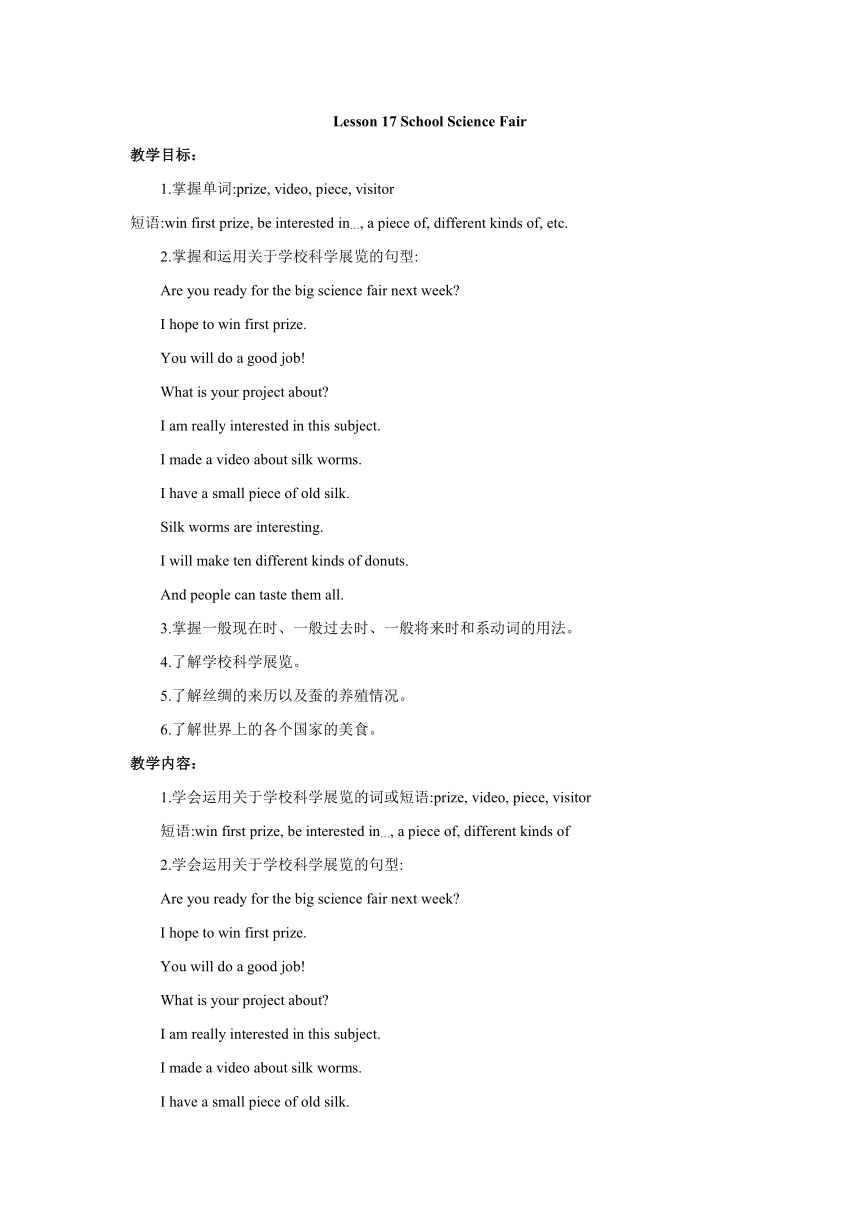 | |
| 格式 | zip | ||
| 文件大小 | 27.7KB | ||
| 资源类型 | 教案 | ||
| 版本资源 | 冀教版 | ||
| 科目 | 英语 | ||
| 更新时间 | 2019-06-27 10:03:40 | ||
图片预览

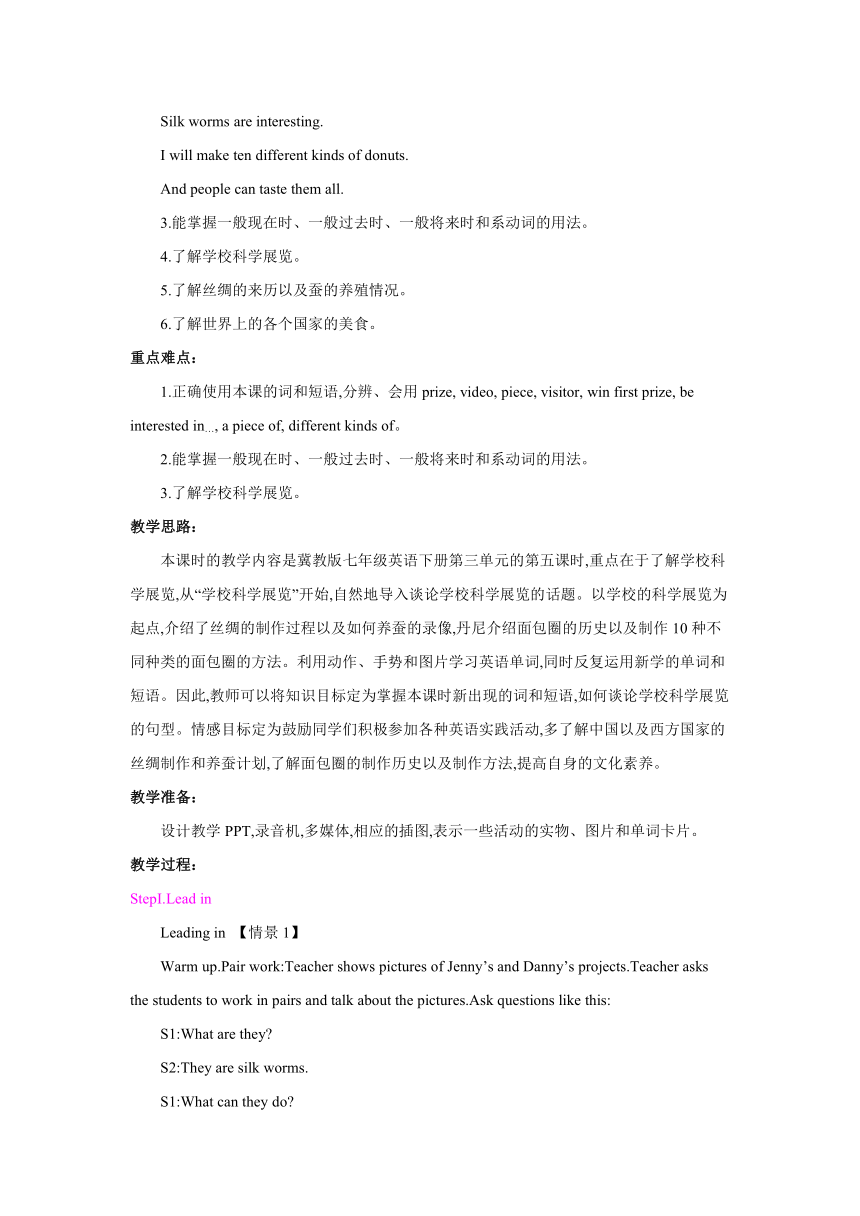
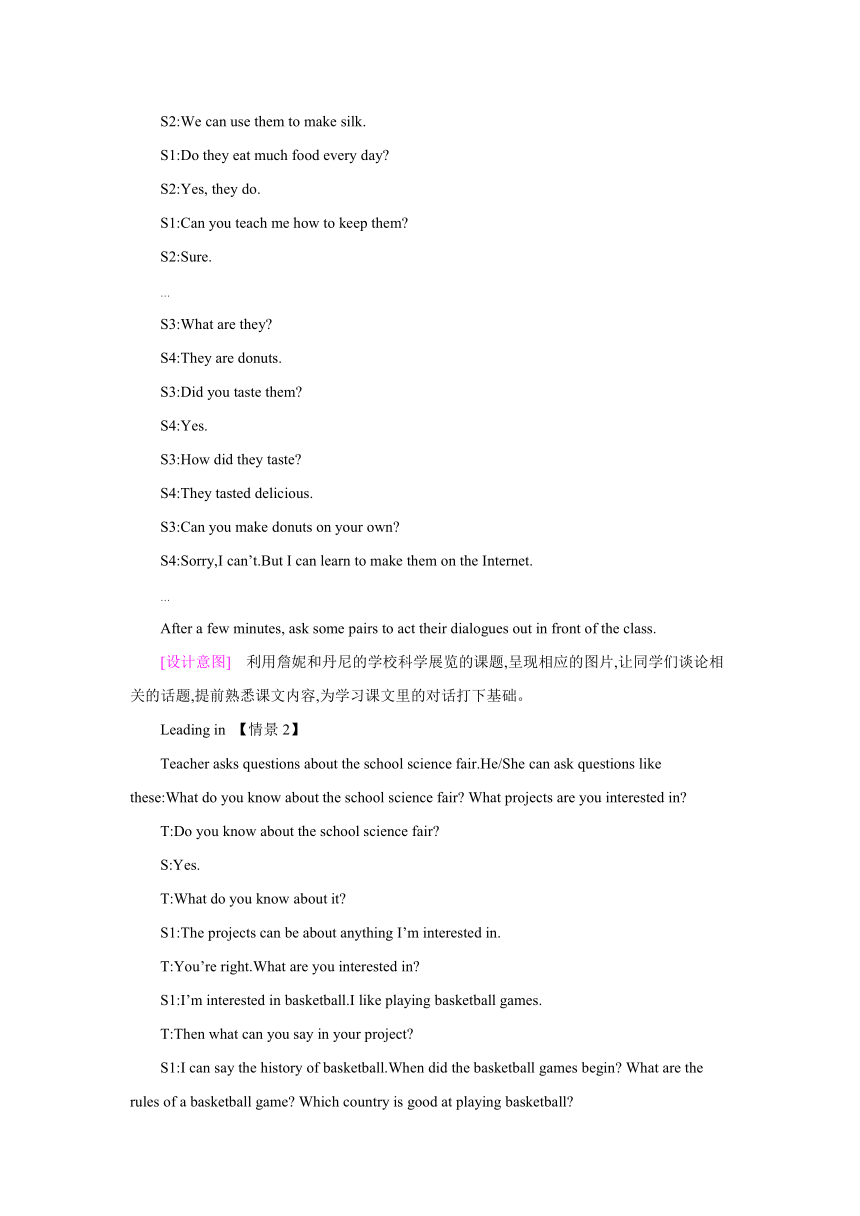
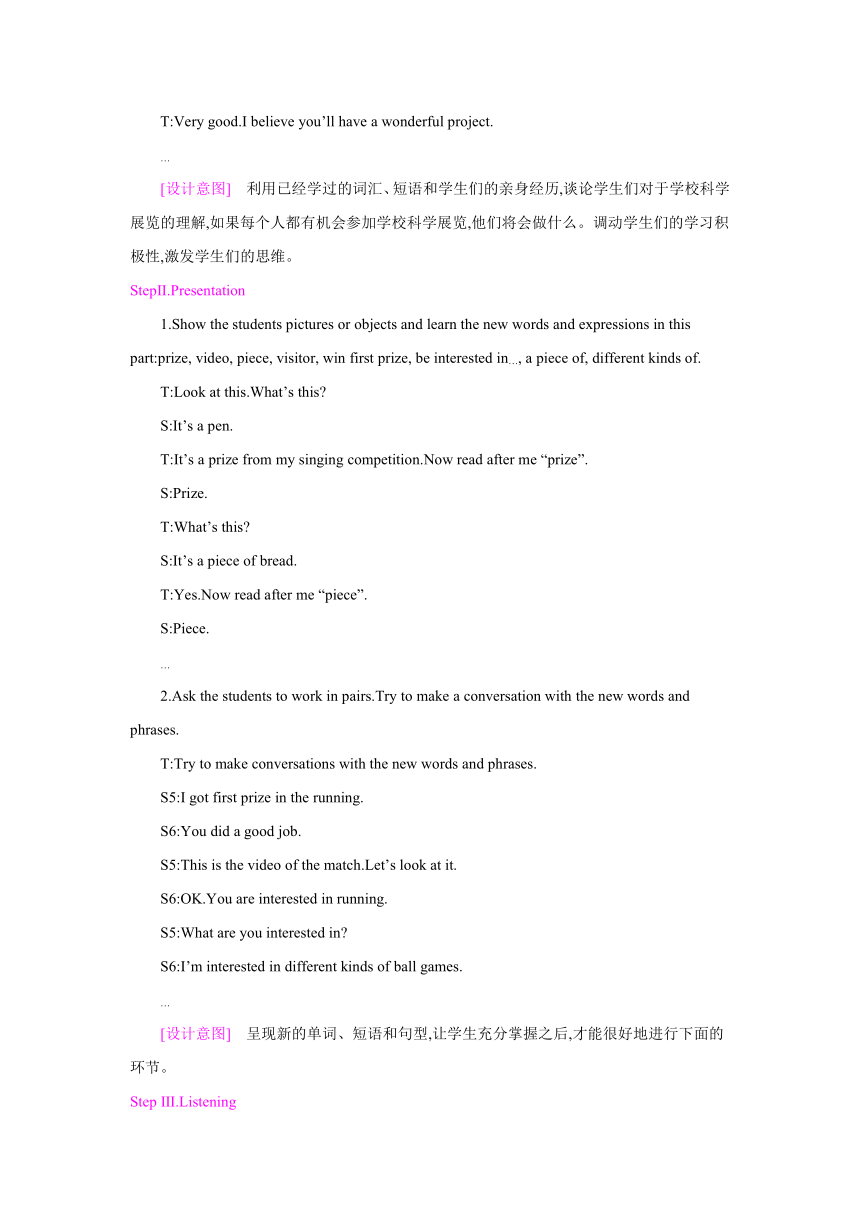
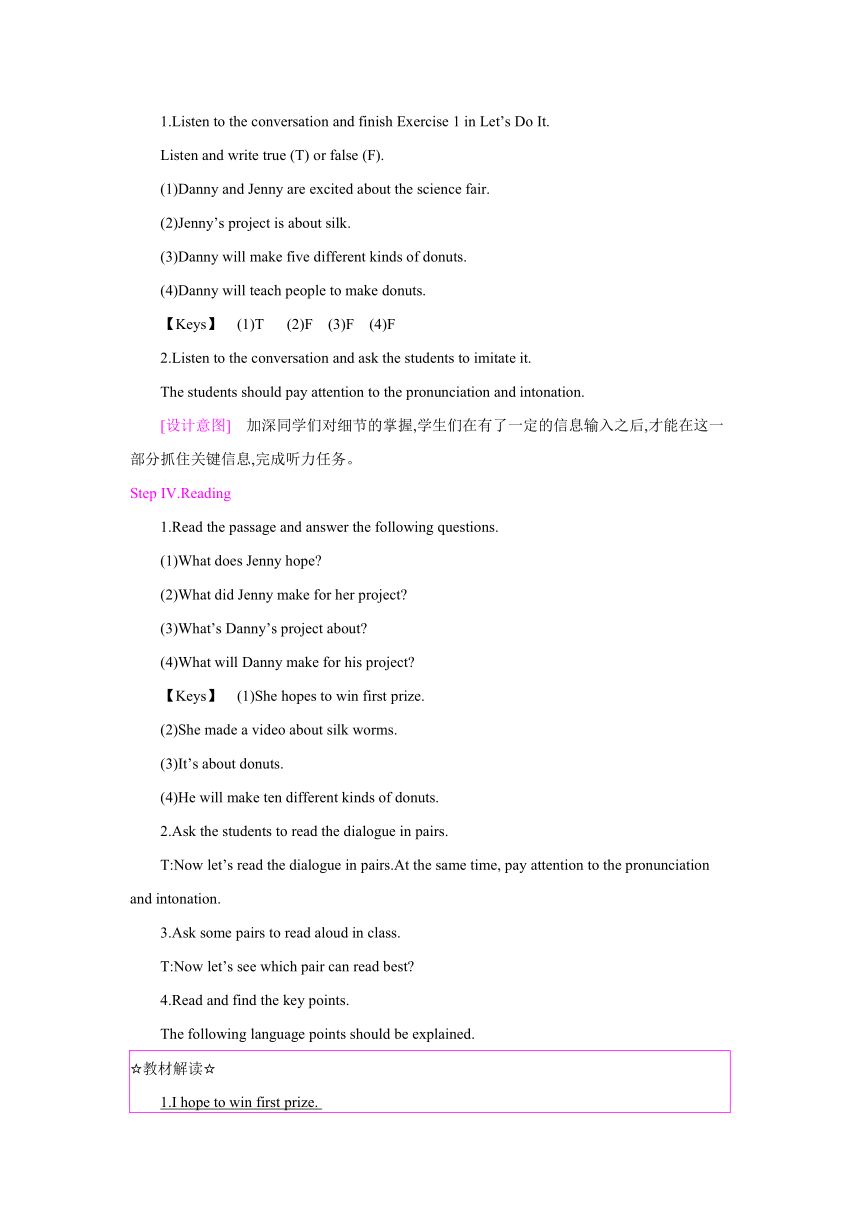
文档简介
Lesson 17 School Science Fair
教学目标:
1.掌握单词:prize, video, piece, visitor
短语:win first prize, be interested in…, a piece of, different kinds of, etc.
2.掌握和运用关于学校科学展览的句型:
Are you ready for the big science fair next week?
I hope to win first prize.
You will do a good job!
What is your project about?
I am really interested in this subject.
I made a video about silk worms.
I have a small piece of old silk.
Silk worms are interesting.
I will make ten different kinds of donuts.
And people can taste them all.
3.掌握一般现在时、一般过去时、一般将来时和系动词的用法。
4.了解学校科学展览。
5.了解丝绸的来历以及蚕的养殖情况。
6.了解世界上的各个国家的美食。
教学内容:
1.学会运用关于学校科学展览的词或短语:prize, video, piece, visitor
短语:win first prize, be interested in…, a piece of, different kinds of
2.学会运用关于学校科学展览的句型:
Are you ready for the big science fair next week?
I hope to win first prize.
You will do a good job!
What is your project about?
I am really interested in this subject.
I made a video about silk worms.
I have a small piece of old silk.
Silk worms are interesting.
I will make ten different kinds of donuts.
And people can taste them all.
3.能掌握一般现在时、一般过去时、一般将来时和系动词的用法。
4.了解学校科学展览。
5.了解丝绸的来历以及蚕的养殖情况。
6.了解世界上的各个国家的美食。
重点难点:
1.正确使用本课的词和短语,分辨、会用prize, video, piece, visitor, win first prize, be interested in…, a piece of, different kinds of。
2.能掌握一般现在时、一般过去时、一般将来时和系动词的用法。
3.了解学校科学展览。
教学思路:
本课时的教学内容是冀教版七年级英语下册第三单元的第五课时,重点在于了解学校科学展览,从“学校科学展览”开始,自然地导入谈论学校科学展览的话题。以学校的科学展览为起点,介绍了丝绸的制作过程以及如何养蚕的录像,丹尼介绍面包圈的历史以及制作10种不同种类的面包圈的方法。利用动作、手势和图片学习英语单词,同时反复运用新学的单词和短语。因此,教师可以将知识目标定为掌握本课时新出现的词和短语,如何谈论学校科学展览的句型。情感目标定为鼓励同学们积极参加各种英语实践活动,多了解中国以及西方国家的丝绸制作和养蚕计划,了解面包圈的制作历史以及制作方法,提高自身的文化素养。
教学准备:
设计教学PPT,录音机,多媒体,相应的插图,表示一些活动的实物、图片和单词卡片。
教学过程:
StepⅠ.Lead in
Leading in 【情景1】
Warm up.Pair work:Teacher shows pictures of Jenny’s and Danny’s projects.Teacher asks the students to work in pairs and talk about the pictures.Ask questions like this:
S1:What are they?
S2:They are silk worms.
S1:What can they do?
S2:We can use them to make silk.
S1:Do they eat much food every day?
S2:Yes, they do.
S1:Can you teach me how to keep them?
S2:Sure.
…
S3:What are they?
S4:They are donuts.
S3:Did you taste them?
S4:Yes.
S3:How did they taste?
S4:They tasted delicious.
S3:Can you make donuts on your own?
S4:Sorry,I can’t.But I can learn to make them on the Internet.
…
After a few minutes, ask some pairs to act their dialogues out in front of the class.
[设计意图] 利用詹妮和丹尼的学校科学展览的课题,呈现相应的图片,让同学们谈论相关的话题,提前熟悉课文内容,为学习课文里的对话打下基础。
Leading in 【情景2】
Teacher asks questions about the school science fair.He/She can ask questions like these:What do you know about the school science fair? What projects are you interested in?
T:Do you know about the school science fair?
S:Yes.
T:What do you know about it?
S1:The projects can be about anything I’m interested in.
T:You’re right.What are you interested in?
S1:I’m interested in basketball.I like playing basketball games.
T:Then what can you say in your project?
S1:I can say the history of basketball.When did the basketball games begin? What are the rules of a basketball game? Which country is good at playing basketball?
T:Very good.I believe you’ll have a wonderful project.
…
[设计意图] 利用已经学过的词汇、短语和学生们的亲身经历,谈论学生们对于学校科学展览的理解,如果每个人都有机会参加学校科学展览,他们将会做什么。调动学生们的学习积极性,激发学生们的思维。
StepⅡ.Presentation
1.Show the students pictures or objects and learn the new words and expressions in this part:prize, video, piece, visitor, win first prize, be interested in…, a piece of, different kinds of.
T:Look at this.What’s this?
S:It’s a pen.
T:It’s a prize from my singing competition.Now read after me “prize”.
S:Prize.
T:What’s this?
S:It’s a piece of bread.
T:Yes.Now read after me “piece”.
S:Piece.
…
2.Ask the students to work in pairs.Try to make a conversation with the new words and phrases.
T:Try to make conversations with the new words and phrases.
S5:I got first prize in the running.
S6:You did a good job.
S5:This is the video of the match.Let’s look at it.
S6:OK.You are interested in running.
S5:What are you interested in?
S6:I’m interested in different kinds of ball games.
…
[设计意图] 呈现新的单词、短语和句型,让学生充分掌握之后,才能很好地进行下面的环节。
Step Ⅲ.Listening
1.Listen to the conversation and finish Exercise 1 in Let’s Do It.
Listen and write true (T) or false (F).
(1)Danny and Jenny are excited about the science fair.
(2)Jenny’s project is about silk.
(3)Danny will make five different kinds of donuts.
(4)Danny will teach people to make donuts.
【Keys】 (1)T (2)F (3)F (4)F
2.Listen to the conversation and ask the students to imitate it.
The students should pay attention to the pronunciation and intonation.
[设计意图] 加深同学们对细节的掌握,学生们在有了一定的信息输入之后,才能在这一部分抓住关键信息,完成听力任务。
Step Ⅳ.Reading
1.Read the passage and answer the following questions.
(1)What does Jenny hope?
(2)What did Jenny make for her project?
(3)What’s Danny’s project about?
(4)What will Danny make for his project?
【Keys】 (1)She hopes to win first prize.
(2)She made a video about silk worms.
(3)It’s about donuts.
(4)He will make ten different kinds of donuts.
2.Ask the students to read the dialogue in pairs.
T:Now let’s read the dialogue in pairs.At the same time, pay attention to the pronunciation and intonation.
3.Ask some pairs to read aloud in class.
T:Now let’s see which pair can read best?
4.Read and find the key points.
The following language points should be explained.
☆教材解读☆
1.I hope to win first prize.?
win first prize 意为“赢得一等奖”,同义短语为 take the first place/get the first place。
He won first prize.
=He took/got the first place.他得了第一。
2.Don’t worry,Jenny.?
此句是由“Don’t+动词原形”构成的祈使句,用来表示请求、命令等。
Don’t be late!别迟到!
3.You will do a great job!?
◆本句常用来表示赞扬或鼓励。还可使用“Well done!/Excellent!”。
◆【辨析】 job,work
(1)job意为“工作,零工”,用作可数名词。
He wanted a job.他想要一份工作。
(2)work意为“工作”,属于不可数名词。
I cannot find work in this town.
我在这个镇里找不到工作。
4.I am really interested in this subject.?
be interested in 意为“对……感兴趣”。
I am interested in English.我对英语感兴趣。
【辨析】 interest,interesting,interested
(1)interest用作不可数名词时意为“兴趣”。用作动词时意为“使感兴趣”,其主语多为事或物。
I have no interest in your plan.
我对你的计划没有兴趣。
(2)interesting用作形容词,意为“令人感兴趣的”,主语通常是物。可以作表语,也可以作定语。
The book is very interesting.
这本书很有趣。
(3)interested用作形容词,意为“感兴趣的;对……感兴趣的”,主语通常是人,且多用于be/get/feel/become interested in结构中。be interested in sth.意为“对某事感兴趣”;be interested in doing sth.意为“对做某事感兴趣”。
He is interested in the film.
他对这部电影感兴趣。
5.I have a small piece of old silk.?
a piece of 意为“一张/片/块”,pieces of 意为“几张/片/块”。
Would you like another piece of bread?
你想再吃片面包吗?
I need ten pieces of paper.我需要十张纸。
6.I will make ten different kinds of donuts.?
短语a kind of意为“一种”,different kinds of则表示“不同种类的”,根据不同情况后加名词单数或复数。
This kind of food sells well.这种食品很畅销。
There are many different kinds of books in our bookstore.我们书店有很多不同种类的书。
[设计意图] 读文章回答问题,找出问题的答案,设计这样的阅读题有助于学生理解文章细节。
StepⅤ.Practice
1.Retell the story.Ask the students to retell the text.Ask a few students to try in class.
2.Work in pairs.Create a new dialogue about the school science fair.Ask a few pairs to act them out in front of the class.
S6:Do you like to cook?
S7:Of course.
S6:What can you cook?
S7:I can cook delicious Western food.
S6:Can you make cakes?
S7:Yes.I can make pizza, sandwiches, hamburgers and donuts.
S6:Oh, you can make a video of making food.
S7:You’re right.My science fair is about food.
…
3.Group work:Ask the students what they are interested in.What’s the project about?
S8:What are you interested in?
S9:I’m interested in making things.
S8:What can you make?
S9:I can make kites,model cars, model planes and many other things.
S8:What’s your project about?
S10:I like making clothes.I have different kinds of clothes to show.
S8:What do you like doing?
S11:I like planting flowers.I have all kinds of flowers in my garden.
…
After the students practice a few minutes, ask some groups to make a report in front of the class with the help of the pictures.
Group 1:My group members like many different kinds of things.Their projects are about different kinds of things.×× likes making things, such as kites, model cars, model planes and many other things.×× likes making clothes.He/She has different kinds of clothes to show.×× likes planting flowers.There are all kinds of flowers in his/her garden.
…
[设计意图] 利用学生们的实物或图片,创设对话,创设不同的场景,让学生有机会进行多方面的口语练习。
Step Ⅵ.Complete Let’s Do It!
We have finished Exercise 1 in listening part.We have finished Exercise 2 in reading part.Ask the students to finish Exercise 3 by themselves.Check the answers in class.
[设计意图] Let’s Do It!部分中的Exercise 1重点是听力教学,在课上作为听力任务完成了。Exercise 2是阅读教学,在阅读部分我们已经完成了。让学生们独立完成Exercise 3,检验短语和课文的掌握程度。
Step Ⅶ.Task
Group work:Let’s Do It! Exercise 4.
Work in groups.Suppose there will be a science fair at your school.How will you present your project? Interview your classmates and fill in the table.
Ask the students to discuss in groups.Create more dialogues.After a few minutes, ask some groups to act their dialogues out in front of the class.
[设计意图] 根据课文内容延续对话,表演的学生可以带着实物、录像或视频,这样大家会更透彻地理解学生们为学校科学展览所设计的课题。
Step Ⅷ.Exercises
Fill in the blanks.
1.孩子们正在谈论学校科学展览。
The children are talking about their .?
2.每个人都想得一等奖。
Everyone wants to .?
3.大部分男孩对打篮球感兴趣。
Most of the boys playing basketball.?
4.这是一块丝绸。你可以做连衣裙。
This is silk.You can make a dress.?
5.在桌子上有许多不同种类的铅笔盒。
There are many pencil-boxes on the desk.?
【Keys】 1.school science fair 2.win first prize 3.are interested in 4.a piece of 5.different kinds of
[设计意图] 以学评教、强化落实。当堂检测主要是由本节内容组成的形成性评价,让学生们巩固本课所学内容。
Step Ⅸ.Homework
1.Remember the words and phrases in this lesson.
2.Read the dialogue after class.
3.Prepare for the next lesson.
[设计意图] 复习、归纳课本内容,课下练习是非常必要的。
Lesson 17 School Science Fair
prize, video, piece, visitor,
win first prize, be interested in…,
a piece of, different kinds of
I hope to win first prize.
You will do a good job.
What is your project about?
I am really interested in this subject.
I made a video about silk worms.
I have a small piece of old silk.
Silk worms are interesting.
And people can taste them all.
I will make ten different kinds of donuts.
Are you ready for the big science fair next week?
教材习题解答
【Keys】3 1.am interested in 2.different kinds of 3.am ready for 4.a piece of 5.did a great job
教学目标:
1.掌握单词:prize, video, piece, visitor
短语:win first prize, be interested in…, a piece of, different kinds of, etc.
2.掌握和运用关于学校科学展览的句型:
Are you ready for the big science fair next week?
I hope to win first prize.
You will do a good job!
What is your project about?
I am really interested in this subject.
I made a video about silk worms.
I have a small piece of old silk.
Silk worms are interesting.
I will make ten different kinds of donuts.
And people can taste them all.
3.掌握一般现在时、一般过去时、一般将来时和系动词的用法。
4.了解学校科学展览。
5.了解丝绸的来历以及蚕的养殖情况。
6.了解世界上的各个国家的美食。
教学内容:
1.学会运用关于学校科学展览的词或短语:prize, video, piece, visitor
短语:win first prize, be interested in…, a piece of, different kinds of
2.学会运用关于学校科学展览的句型:
Are you ready for the big science fair next week?
I hope to win first prize.
You will do a good job!
What is your project about?
I am really interested in this subject.
I made a video about silk worms.
I have a small piece of old silk.
Silk worms are interesting.
I will make ten different kinds of donuts.
And people can taste them all.
3.能掌握一般现在时、一般过去时、一般将来时和系动词的用法。
4.了解学校科学展览。
5.了解丝绸的来历以及蚕的养殖情况。
6.了解世界上的各个国家的美食。
重点难点:
1.正确使用本课的词和短语,分辨、会用prize, video, piece, visitor, win first prize, be interested in…, a piece of, different kinds of。
2.能掌握一般现在时、一般过去时、一般将来时和系动词的用法。
3.了解学校科学展览。
教学思路:
本课时的教学内容是冀教版七年级英语下册第三单元的第五课时,重点在于了解学校科学展览,从“学校科学展览”开始,自然地导入谈论学校科学展览的话题。以学校的科学展览为起点,介绍了丝绸的制作过程以及如何养蚕的录像,丹尼介绍面包圈的历史以及制作10种不同种类的面包圈的方法。利用动作、手势和图片学习英语单词,同时反复运用新学的单词和短语。因此,教师可以将知识目标定为掌握本课时新出现的词和短语,如何谈论学校科学展览的句型。情感目标定为鼓励同学们积极参加各种英语实践活动,多了解中国以及西方国家的丝绸制作和养蚕计划,了解面包圈的制作历史以及制作方法,提高自身的文化素养。
教学准备:
设计教学PPT,录音机,多媒体,相应的插图,表示一些活动的实物、图片和单词卡片。
教学过程:
StepⅠ.Lead in
Leading in 【情景1】
Warm up.Pair work:Teacher shows pictures of Jenny’s and Danny’s projects.Teacher asks the students to work in pairs and talk about the pictures.Ask questions like this:
S1:What are they?
S2:They are silk worms.
S1:What can they do?
S2:We can use them to make silk.
S1:Do they eat much food every day?
S2:Yes, they do.
S1:Can you teach me how to keep them?
S2:Sure.
…
S3:What are they?
S4:They are donuts.
S3:Did you taste them?
S4:Yes.
S3:How did they taste?
S4:They tasted delicious.
S3:Can you make donuts on your own?
S4:Sorry,I can’t.But I can learn to make them on the Internet.
…
After a few minutes, ask some pairs to act their dialogues out in front of the class.
[设计意图] 利用詹妮和丹尼的学校科学展览的课题,呈现相应的图片,让同学们谈论相关的话题,提前熟悉课文内容,为学习课文里的对话打下基础。
Leading in 【情景2】
Teacher asks questions about the school science fair.He/She can ask questions like these:What do you know about the school science fair? What projects are you interested in?
T:Do you know about the school science fair?
S:Yes.
T:What do you know about it?
S1:The projects can be about anything I’m interested in.
T:You’re right.What are you interested in?
S1:I’m interested in basketball.I like playing basketball games.
T:Then what can you say in your project?
S1:I can say the history of basketball.When did the basketball games begin? What are the rules of a basketball game? Which country is good at playing basketball?
T:Very good.I believe you’ll have a wonderful project.
…
[设计意图] 利用已经学过的词汇、短语和学生们的亲身经历,谈论学生们对于学校科学展览的理解,如果每个人都有机会参加学校科学展览,他们将会做什么。调动学生们的学习积极性,激发学生们的思维。
StepⅡ.Presentation
1.Show the students pictures or objects and learn the new words and expressions in this part:prize, video, piece, visitor, win first prize, be interested in…, a piece of, different kinds of.
T:Look at this.What’s this?
S:It’s a pen.
T:It’s a prize from my singing competition.Now read after me “prize”.
S:Prize.
T:What’s this?
S:It’s a piece of bread.
T:Yes.Now read after me “piece”.
S:Piece.
…
2.Ask the students to work in pairs.Try to make a conversation with the new words and phrases.
T:Try to make conversations with the new words and phrases.
S5:I got first prize in the running.
S6:You did a good job.
S5:This is the video of the match.Let’s look at it.
S6:OK.You are interested in running.
S5:What are you interested in?
S6:I’m interested in different kinds of ball games.
…
[设计意图] 呈现新的单词、短语和句型,让学生充分掌握之后,才能很好地进行下面的环节。
Step Ⅲ.Listening
1.Listen to the conversation and finish Exercise 1 in Let’s Do It.
Listen and write true (T) or false (F).
(1)Danny and Jenny are excited about the science fair.
(2)Jenny’s project is about silk.
(3)Danny will make five different kinds of donuts.
(4)Danny will teach people to make donuts.
【Keys】 (1)T (2)F (3)F (4)F
2.Listen to the conversation and ask the students to imitate it.
The students should pay attention to the pronunciation and intonation.
[设计意图] 加深同学们对细节的掌握,学生们在有了一定的信息输入之后,才能在这一部分抓住关键信息,完成听力任务。
Step Ⅳ.Reading
1.Read the passage and answer the following questions.
(1)What does Jenny hope?
(2)What did Jenny make for her project?
(3)What’s Danny’s project about?
(4)What will Danny make for his project?
【Keys】 (1)She hopes to win first prize.
(2)She made a video about silk worms.
(3)It’s about donuts.
(4)He will make ten different kinds of donuts.
2.Ask the students to read the dialogue in pairs.
T:Now let’s read the dialogue in pairs.At the same time, pay attention to the pronunciation and intonation.
3.Ask some pairs to read aloud in class.
T:Now let’s see which pair can read best?
4.Read and find the key points.
The following language points should be explained.
☆教材解读☆
1.I hope to win first prize.?
win first prize 意为“赢得一等奖”,同义短语为 take the first place/get the first place。
He won first prize.
=He took/got the first place.他得了第一。
2.Don’t worry,Jenny.?
此句是由“Don’t+动词原形”构成的祈使句,用来表示请求、命令等。
Don’t be late!别迟到!
3.You will do a great job!?
◆本句常用来表示赞扬或鼓励。还可使用“Well done!/Excellent!”。
◆【辨析】 job,work
(1)job意为“工作,零工”,用作可数名词。
He wanted a job.他想要一份工作。
(2)work意为“工作”,属于不可数名词。
I cannot find work in this town.
我在这个镇里找不到工作。
4.I am really interested in this subject.?
be interested in 意为“对……感兴趣”。
I am interested in English.我对英语感兴趣。
【辨析】 interest,interesting,interested
(1)interest用作不可数名词时意为“兴趣”。用作动词时意为“使感兴趣”,其主语多为事或物。
I have no interest in your plan.
我对你的计划没有兴趣。
(2)interesting用作形容词,意为“令人感兴趣的”,主语通常是物。可以作表语,也可以作定语。
The book is very interesting.
这本书很有趣。
(3)interested用作形容词,意为“感兴趣的;对……感兴趣的”,主语通常是人,且多用于be/get/feel/become interested in结构中。be interested in sth.意为“对某事感兴趣”;be interested in doing sth.意为“对做某事感兴趣”。
He is interested in the film.
他对这部电影感兴趣。
5.I have a small piece of old silk.?
a piece of 意为“一张/片/块”,pieces of 意为“几张/片/块”。
Would you like another piece of bread?
你想再吃片面包吗?
I need ten pieces of paper.我需要十张纸。
6.I will make ten different kinds of donuts.?
短语a kind of意为“一种”,different kinds of则表示“不同种类的”,根据不同情况后加名词单数或复数。
This kind of food sells well.这种食品很畅销。
There are many different kinds of books in our bookstore.我们书店有很多不同种类的书。
[设计意图] 读文章回答问题,找出问题的答案,设计这样的阅读题有助于学生理解文章细节。
StepⅤ.Practice
1.Retell the story.Ask the students to retell the text.Ask a few students to try in class.
2.Work in pairs.Create a new dialogue about the school science fair.Ask a few pairs to act them out in front of the class.
S6:Do you like to cook?
S7:Of course.
S6:What can you cook?
S7:I can cook delicious Western food.
S6:Can you make cakes?
S7:Yes.I can make pizza, sandwiches, hamburgers and donuts.
S6:Oh, you can make a video of making food.
S7:You’re right.My science fair is about food.
…
3.Group work:Ask the students what they are interested in.What’s the project about?
S8:What are you interested in?
S9:I’m interested in making things.
S8:What can you make?
S9:I can make kites,model cars, model planes and many other things.
S8:What’s your project about?
S10:I like making clothes.I have different kinds of clothes to show.
S8:What do you like doing?
S11:I like planting flowers.I have all kinds of flowers in my garden.
…
After the students practice a few minutes, ask some groups to make a report in front of the class with the help of the pictures.
Group 1:My group members like many different kinds of things.Their projects are about different kinds of things.×× likes making things, such as kites, model cars, model planes and many other things.×× likes making clothes.He/She has different kinds of clothes to show.×× likes planting flowers.There are all kinds of flowers in his/her garden.
…
[设计意图] 利用学生们的实物或图片,创设对话,创设不同的场景,让学生有机会进行多方面的口语练习。
Step Ⅵ.Complete Let’s Do It!
We have finished Exercise 1 in listening part.We have finished Exercise 2 in reading part.Ask the students to finish Exercise 3 by themselves.Check the answers in class.
[设计意图] Let’s Do It!部分中的Exercise 1重点是听力教学,在课上作为听力任务完成了。Exercise 2是阅读教学,在阅读部分我们已经完成了。让学生们独立完成Exercise 3,检验短语和课文的掌握程度。
Step Ⅶ.Task
Group work:Let’s Do It! Exercise 4.
Work in groups.Suppose there will be a science fair at your school.How will you present your project? Interview your classmates and fill in the table.
Ask the students to discuss in groups.Create more dialogues.After a few minutes, ask some groups to act their dialogues out in front of the class.
[设计意图] 根据课文内容延续对话,表演的学生可以带着实物、录像或视频,这样大家会更透彻地理解学生们为学校科学展览所设计的课题。
Step Ⅷ.Exercises
Fill in the blanks.
1.孩子们正在谈论学校科学展览。
The children are talking about their .?
2.每个人都想得一等奖。
Everyone wants to .?
3.大部分男孩对打篮球感兴趣。
Most of the boys playing basketball.?
4.这是一块丝绸。你可以做连衣裙。
This is silk.You can make a dress.?
5.在桌子上有许多不同种类的铅笔盒。
There are many pencil-boxes on the desk.?
【Keys】 1.school science fair 2.win first prize 3.are interested in 4.a piece of 5.different kinds of
[设计意图] 以学评教、强化落实。当堂检测主要是由本节内容组成的形成性评价,让学生们巩固本课所学内容。
Step Ⅸ.Homework
1.Remember the words and phrases in this lesson.
2.Read the dialogue after class.
3.Prepare for the next lesson.
[设计意图] 复习、归纳课本内容,课下练习是非常必要的。
Lesson 17 School Science Fair
prize, video, piece, visitor,
win first prize, be interested in…,
a piece of, different kinds of
I hope to win first prize.
You will do a good job.
What is your project about?
I am really interested in this subject.
I made a video about silk worms.
I have a small piece of old silk.
Silk worms are interesting.
And people can taste them all.
I will make ten different kinds of donuts.
Are you ready for the big science fair next week?
教材习题解答
【Keys】3 1.am interested in 2.different kinds of 3.am ready for 4.a piece of 5.did a great job
同课章节目录
- Unit 1 A Trip to the Silk Road
- Lesson 1 A Trip to China
- Lesson 2 Meet You in Beijing
- Lesson 3 A Visit to Xi'an
- Lesson 4 A Visit to Lanzhou
- Lesson 5 Another Stop along the Silk Road
- Lesson 6 Jenny's Diary
- Unit 2 It's Show Time!
- Lesson 7 What's Your Project about?
- Lesson 8 Marco Polo and the Silk Road
- Lesson 9 Danny's School Project
- Lesson 10 Music and Dance
- Lesson 11 Food in China
- Lesson 12 A Blog about the Silk Road
- Unit 3 School Life
- Lesson 13 How Is School Going?
- Lesson 14 Jenny's School Life
- Lesson 15 Making a Difference
- Lesson 16 We Are with You!
- Lesson 17 School Science Fai
- Lesson 18 Teaching in China
- Unit 4 After-School Activities
- Lesson 19 A Dinner Date
- Lesson 20 Join Our Club!
- Lesson 21 What Is Your Club Type?
- Lesson 22 Big Plans for the Weekend
- Lesson 23 A Weekend with Grandma
- Lesson 24 How was Your Weekend?
- Unit 5 I Love Learning English!
- Lesson 25 A Phone Friend
- Lesson 26 Online Phone Calls
- Lesson 27 Amazing English
- Lesson 28 How Do I Learn English?
- Lesson 29 A Door to the World
- Lesson 30 Writing an E-mail in English
- Unit 6 Seasons
- Lesson 31 What Strange Weather!
- Lesson 32 I Can't Wait for Winter!
- Lesson 33 Kim's Favourite Season
- Lesson 34 Steven's Report
- Lesson 35 Surfing in Sydney
- Lesson 36 Spring in China
- Unit 7 Sports and Good Health
- Lesson 37 You Are What You Eat!
- Lesson 38 Stay Healthy!
- Lesson 39 Danny's Report
- Lesson 40 Move Your Body
- Lesson 41 Were People Healthy Then?
- Lesson 42 Know Yourself
- Unit 8 Summer Holiday Is Coming!
- Lesson 43 Have a Good Summer!
- Lesson 44 Volunteering in Summe
- Lesson 45 Baseball Season
- Lesson 46 Get Ready for Summer Holiday!
- Lesson 47 Summer Plans
- Lesson 48 Li Ming's Summer Holiday
